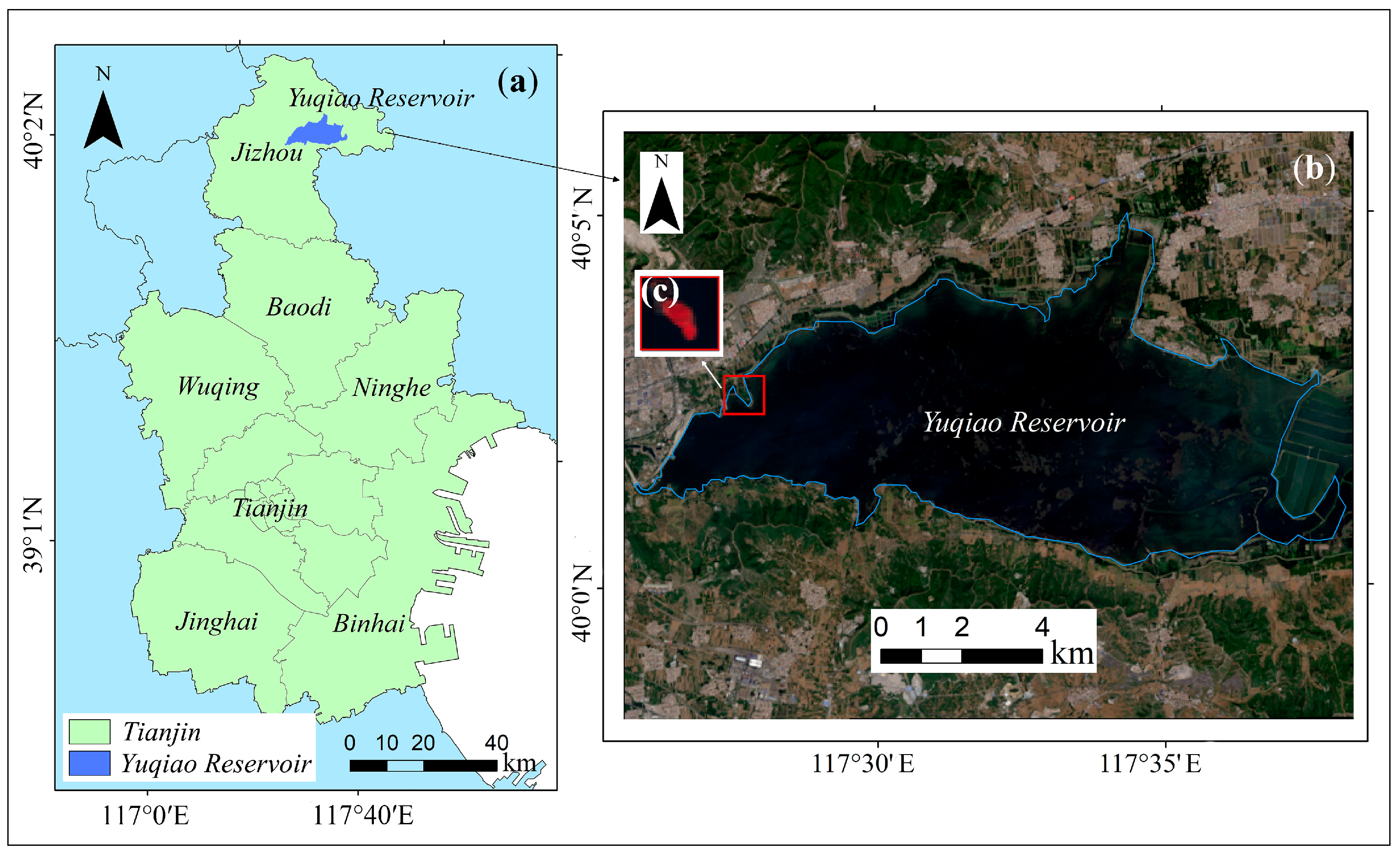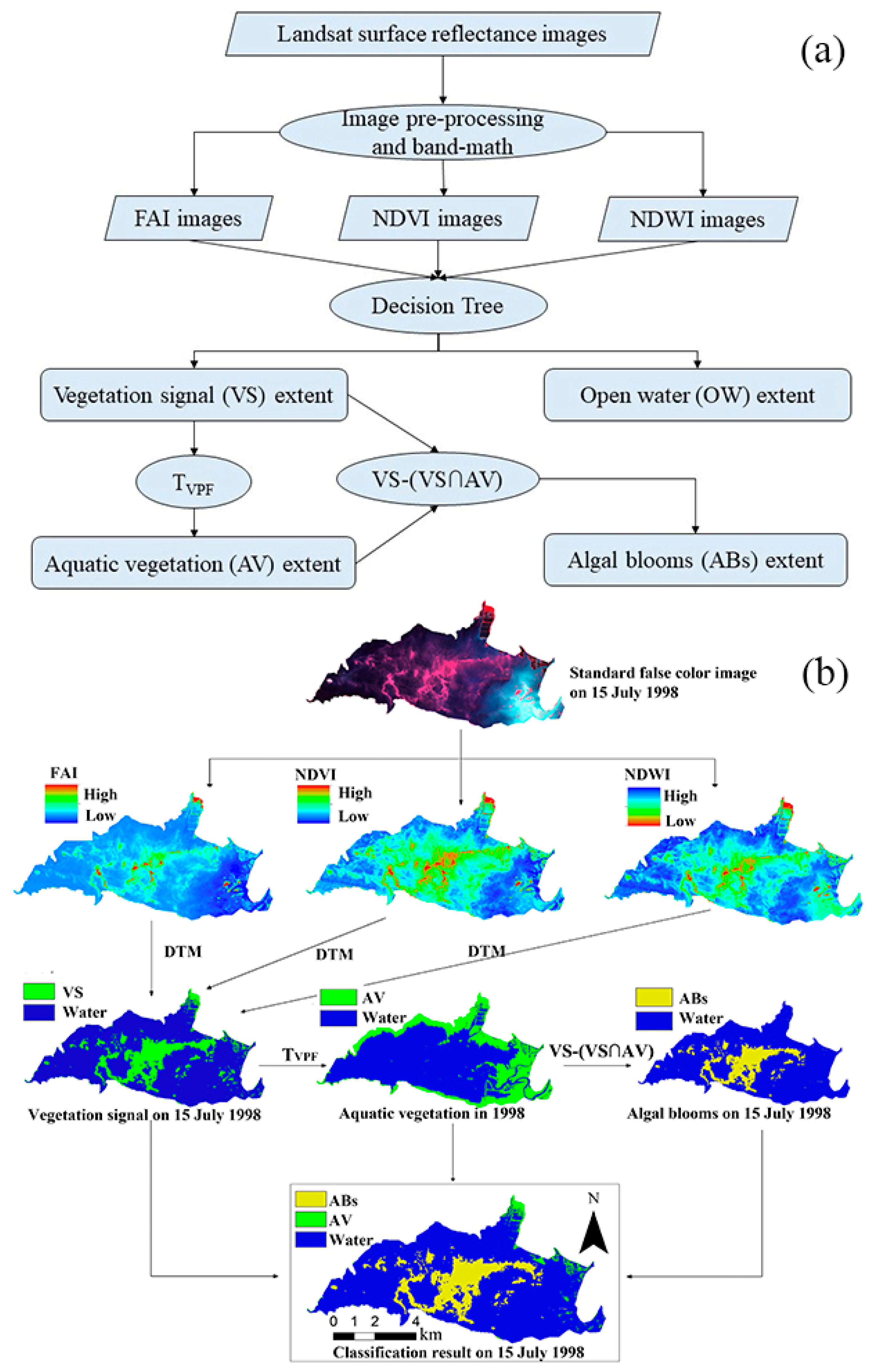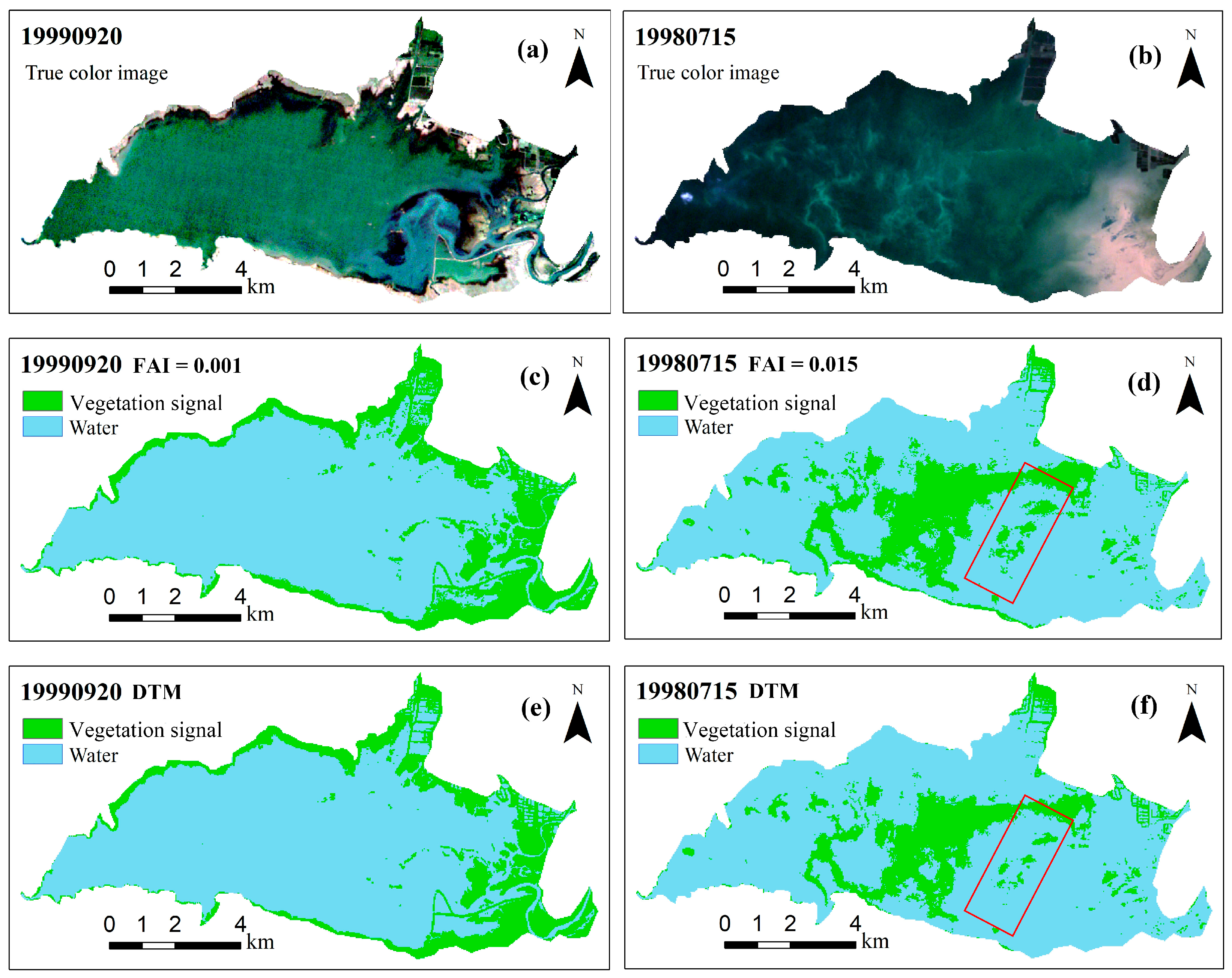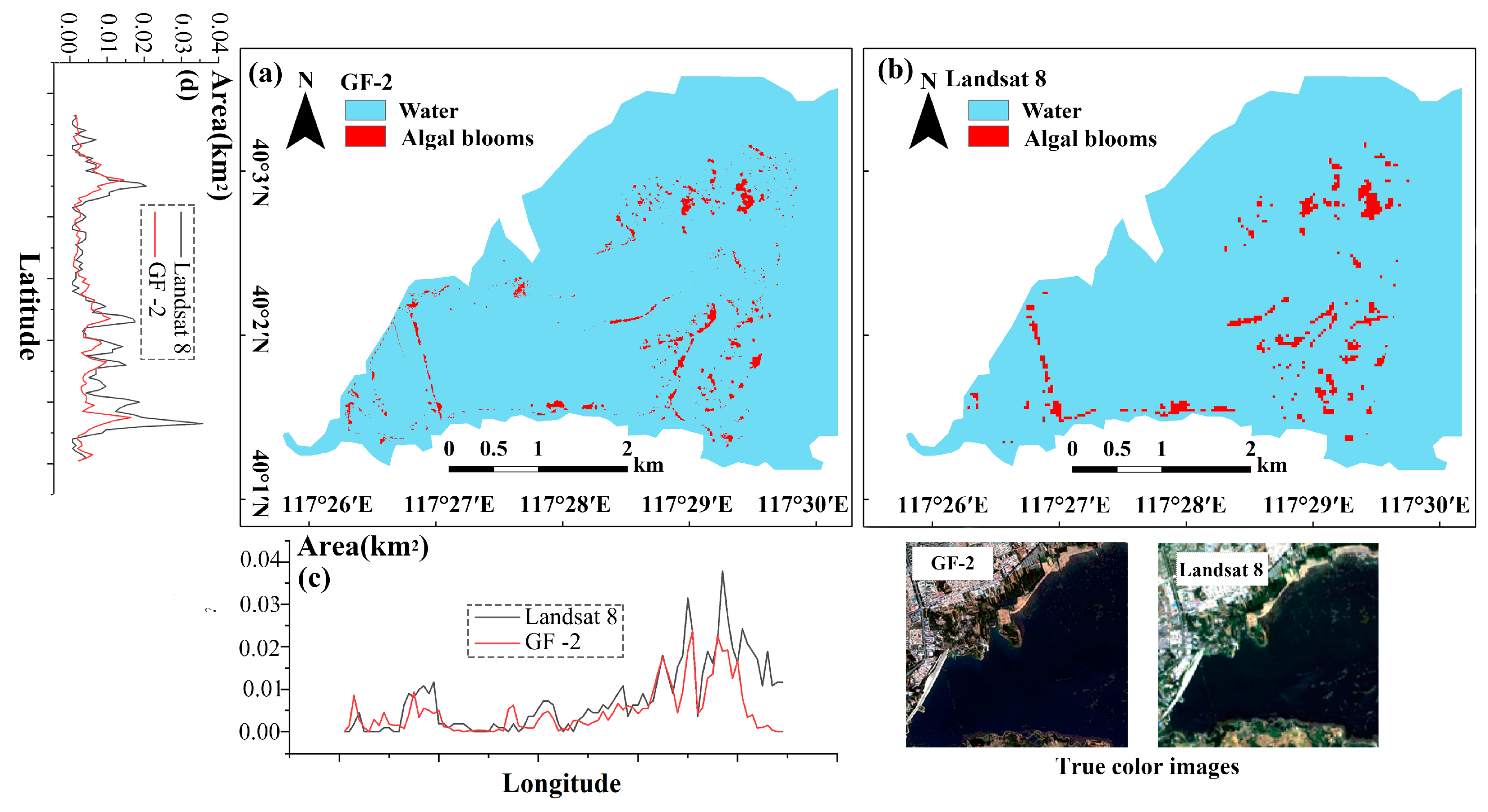Mapping Algal Blooms in Aquatic Ecosystems Using Long-Term Landsat Data: A Case Study of Yuqiao Reservoir from 1984–2022
Abstract
:1. Introduction
2. Materials and Methods
2.1. Materials
2.2. Method Description
2.2.1. Multi-Index Decision Tree Model
2.2.2. Vegetation Presence Frequency (VPF)
2.3. Accuracy Assessment
2.4. Statistical Analyses
3. Results
3.1. Method Development
3.1.1. Separating VS and Water
3.1.2. Separating ABs and AV
- Image selection
- VPF threshold determination
3.2. Validation by GF-2 PMS Data
3.3. Spatial and Temporal Dynamics of AB Distribution
4. Discussions
4.1. Advantages of the Method
4.2. Limitations of the Method
4.3. Human Factors Influencing the Spatial and Temporal Variations of ABs
5. Conclusions
Author Contributions
Funding
Data Availability Statement
Conflicts of Interest
References
- Pekel, J.-F.; Cottam, A.; Gorelick, N.; Belward, A.S. High-resolution mapping of global surface water and its long-term changes. Nature 2016, 540, 418–422. [Google Scholar] [CrossRef]
- Huang, S.; Zhang, K.; Lin, Q.; Liu, J.; Shen, J. Abrupt ecological shifts of lakes during the Anthropocene. Earth-Sci. Rev. 2022, 227, 103981. [Google Scholar] [CrossRef]
- Fang, C.; Song, K.; Paerl, H.W.; Jacinthe, P.A.; Wen, Z.; Liu, G.; Tao, H.; Xu, X.; Kutser, T.; Wang, Z. Global divergent trends of algal blooms detected by satellite during 1982–2018. Glob. Chang. Biol. 2022, 28, 2327–2340. [Google Scholar] [CrossRef]
- Dalby, S. Climate change: New dimensions environmental security. RUSI J. 2013, 158, 34–43. [Google Scholar] [CrossRef]
- Alexander, T.J.; Vonlanthen, P.; Seehausen, O. Does eutrophication-driven evolution change aquatic ecosystems? Philos. Trans. R. Soc. B Biol. Sci. 2017, 372, 20160041. [Google Scholar] [CrossRef]
- Codd, G.A. Cyanobacterial toxins, the perception of water quality, and the prioritisation of eutrophication control. Ecol. Eng. 2000, 16, 51–60. [Google Scholar] [CrossRef]
- Qin, B.; Yang, G.; Ma, J.; Wu, T.; Li, W.; Liu, L.; Deng, J.; Zhou, J. Spatiotemporal changes of cyanobacterial bloom in large shallow eutrophic Lake Taihu, China. Front. Microbiol. 2018, 9, 451. [Google Scholar] [CrossRef]
- Zhu, S.; Wu, Y.; Ma, X. Deep Learning-Based Algal Bloom Identification Method from Remote Sensing Images—Take China’s Chaohu Lake as an Example. Sustainability 2023, 15, 4545. [Google Scholar] [CrossRef]
- Jing, Y.; Zhang, Y.; Hu, M.; Chu, Q.; Ma, R. MODIS-satellite-based analysis of long-term temporal-spatial dynamics and drivers of algal blooms in a plateau lake Dianchi, China. Remote Sens. 2019, 11, 2582. [Google Scholar] [CrossRef]
- Lunetta, R.S.; Schaeffer, B.A.; Stumpf, R.P.; Keith, D.; Jacobs, S.A.; Murphy, M.S. Evaluation of cyanobacteria cell count detection derived from MERIS imagery across the eastern USA. Remote Sens. Environ. 2015, 157, 24–34. [Google Scholar] [CrossRef]
- Mishra, S.; Mishra, D. A novel remote sensing algorithm to quantify phycocyanin in cyanobacterial algal blooms. Environ. Res. Lett. 2014, 9, 114003. [Google Scholar] [CrossRef]
- Ogashawara, I.; Mishra, D.R.; Gitelson, A.A. Remote sensing of inland waters: Background and current state-of-the-art. In Bio-Optical Modeling and Remote Sensing of Inland Waters; Elsevier: Amsterdam, The Netherlands, 2017; pp. 1–24. [Google Scholar]
- Meinson, P.; Idrizaj, A.; Nõges, P.; Nõges, T.; Laas, A. Continuous and high-frequency measurements in limnology: History, applications, and future challenges. Environ. Rev. 2016, 24, 52–62. [Google Scholar] [CrossRef]
- Pan, D.; Ma, R. Several key problems of lake water quality remote sensing. J. Lake Sci. 2008, 20, 139–144. [Google Scholar]
- Gai, Y.; Yu, D.; Zhou, Y.; Yang, L.; Chen, C.; Chen, J. An improved model for chlorophyll-a concentration retrieval in coastal waters based on UAV-Borne hyperspectral imagery: A case study in Qingdao, China. Water 2020, 12, 2769. [Google Scholar] [CrossRef]
- Hu, C.; Muller-Karger, F.E.; Taylor, C.J.; Carder, K.L.; Kelble, C.; Johns, E.; Heil, C.A. Red tide detection and tracing using MODIS fluorescence data: A regional example in SW Florida coastal waters. Remote Sens. Environ. 2005, 97, 311–321. [Google Scholar] [CrossRef]
- Hou, T.; Sun, W.; Chen, C.; Yang, G.; Meng, X.; Peng, J. Marine floating raft aquaculture extraction of hyperspectral remote sensing images based decision tree algorithm. Int. J. Appl. Earth Obs. Geoinf. 2022, 111, 102846. [Google Scholar] [CrossRef]
- Hu, C. A novel ocean color index to detect floating algae in the global oceans. Remote Sens. Environ. 2009, 113, 2118–2129. [Google Scholar] [CrossRef]
- Hu, C.; Lee, Z.; Ma, R.; Yu, K.; Li, D.; Shang, S. Moderate resolution imaging spectroradiometer (MODIS) observations of cyanobacteria blooms in Taihu Lake, China. J. Geophys. Res. Ocean. 2010, 115. [Google Scholar] [CrossRef]
- Shurin, J.B.; Abbott, R.L.; Deal, M.S.; Kwan, G.T.; Litchman, E.; McBride, R.C.; Mandal, S.; Smith, V.H. Industrial-strength ecology: Trade-offs and opportunities in algal biofuel production. Ecol. Lett. 2013, 16, 1393–1404. [Google Scholar] [CrossRef]
- Pu, J.; Song, K.; Liu, G.; Wen, Z.; Fang, C.; Hou, J.; Lv, Y. Differentiation of Algal Blooms and Aquatic Vegetation in Chinese Lakes Using Modified Vegetation Presence Frequency Index Method. Chin. Geogr. Sci. 2022, 32, 792–807. [Google Scholar] [CrossRef]
- Luo, J.; Ma, R.; Duan, H.; Hu, W.; Zhu, J.; Huang, W.; Lin, C. A new method for modifying thresholds in the classification of tree models for mapping aquatic vegetation in Taihu Lake with satellite images. Remote Sens. 2014, 6, 7442–7462. [Google Scholar] [CrossRef]
- Qing, S.; Runa, A.; Shun, B.; Zhao, W.; Bao, Y.; Hao, Y. Distinguishing and mapping of aquatic vegetations and yellow algae bloom with Landsat satellite data in a complex shallow Lake, China during 1986–2018. Ecol. Indic. 2020, 112, 106073. [Google Scholar] [CrossRef]
- Liu, X.; Zhang, Y.; Shi, K.; Zhou, Y.; Tang, X.; Zhu, G.; Qin, B. Mapping aquatic vegetation in a large, shallow eutrophic lake: A frequency-based approach using multiple years of MODIS data. Remote Sens. 2015, 7, 10295–10320. [Google Scholar] [CrossRef]
- Fang, C.; Luo, K.; Kong, Y.; Lin, H.; Ren, Y. Evaluating performance and elucidating the mechanisms of collaborative development within the Beijing–Tianjin–Hebei region, China. Sustainability 2018, 10, 471. [Google Scholar] [CrossRef]
- Yue, A.; Zeng, Q.; Wang, H. Remote sensing long-term monitoring of cyanobacterial blooms in yuqiao reservoir. Remote Sens. Technol. Appl. 2020, 35, 694–701. [Google Scholar]
- Cao, X.; Wang, C.; Lu, Y.; Zhang, M.; Khan, K.; Song, S.; Wang, P.; Wang, C. Occurrence, sources and health risk of polyfluoroalkyl substances (PFASs) in soil, water and sediment from a drinking water source area. Ecotoxicol. Environ. Saf. 2019, 174, 208–217. [Google Scholar] [CrossRef]
- Zhang, C.; Gao, X.; Wang, L.; Chen, X. Modelling the role of epiphyton and water level for submerged macrophyte development with a modified submerged aquatic vegetation model in a shallow reservoir in China. Ecol. Eng. 2015, 81, 123–132. [Google Scholar] [CrossRef]
- Zhang, Y.; Jeppesen, E.; Liu, X.; Qin, B.; Shi, K.; Zhou, Y.; Thomaz, S.M.; Deng, J. Global loss of aquatic vegetation in lakes. Earth-Sci. Rev. 2017, 173, 259–265. [Google Scholar] [CrossRef]
- Yang, F.; Sun, C.; Wang, H.; Hu, X.; Wang, S.; Zhang, M.; Zhang, L.; Zhong, J. Significant spatiotemporal variability of nitrous oxide emissions from a temperate reservoir experiencing intensive aquaculture disturbance. Agric. Ecosyst. Environ. 2023, 348, 108427. [Google Scholar] [CrossRef]
- Song, C.; Woodcock, C.E.; Seto, K.C.; Lenney, M.P.; Macomber, S.A. Classification and change detection using Landsat TM data: When and how to correct atmospheric effects? Remote Sens. Environ. 2001, 75, 230–244. [Google Scholar] [CrossRef]
- Cao, X.; Jiang, H.; Zhang, Z.; He, G.; Wang, M.; Long, T.; Wang, G.; Zhang, X. Research progress of Landsat series satellite surface reflectivity products. Surv. Mapp. Spat. Geogr. Inf. 2019, 42, 4. [Google Scholar]
- Bijeesh, T.V.; Narasimhamurthy, K.N. Surface water detection and delineation using remote sensing images: A review of methods and algorithms. Sustain. Water Resour. Manag. 2020, 6, 68. [Google Scholar] [CrossRef]
- Wersal, R.M.; Madsen, J.D. Designing and using phenological studies to define management strategies for aquatic plants. J. Aquat. Plant Manag. 2018, 56, 83–89. [Google Scholar]
- Ardyna, M.; Mundy, C.; Mayot, N.; Matthes, L.C.; Oziel, L.; Horvat, C.; Leu, E.; Assmy, P.; Hill, V.; Matrai, P.A. Under-ice phytoplankton blooms: Shedding light on the “invisible” part of Arctic primary production. Front. Mar. Sci. 2020, 7, 608032. [Google Scholar] [CrossRef]
- Investigation and analysis on biodiversity of large aquatic plants in Yuqiao Reservoir. Mod. Agric. Sci. Technol. 2018, 3.
- Bland, J.; Altman, D. A note on the use of the intraclass correlation coefficient in the evaluation of agreement between two methods of measurement. Comput. Biol. Med. 1990, 20, 337–340. [Google Scholar] [CrossRef]
- Nakagawa, S.; Johnson, P.C.; Schielzeth, H. The coefficient of determination R 2 and intra-class correlation coefficient from generalized linear mixed-effects models revisited and expanded. J. R. Soc. Interface 2017, 14, 20170213. [Google Scholar] [CrossRef]
- Yen, M.; Lo, L.-H. Examining test-retest reliability: An intra-class correlation approach. Nurs. Res. 2002, 51, 59–62. [Google Scholar] [CrossRef]
- Chen, C.-C.; Barnhart, H.X. Comparison of ICC and CCC for assessing agreement for data without and with replications. Comput. Stat. Data Anal. 2008, 53, 554–564. [Google Scholar] [CrossRef]
- Cicchetti, D.V. Guidelines, criteria, and rules of thumb for evaluating normed and standardized assessment instruments in psychology. Psychol. Assess. 1994, 6, 284. [Google Scholar] [CrossRef]
- Zhang, Y.; Ma, R.; Duan, H.; Loiselle, S.A.; Xu, J.; Ma, M. A novel algorithm to estimate algal bloom coverage to subpixel resolution in Lake Taihu. IEEE J. Sel. Top. Appl. Earth Obs. Remote Sens. 2014, 7, 3060–3068. [Google Scholar] [CrossRef]
- Wang, Q.; Sun, L.; Zhu, Y.; Wang, S.; Duan, C.; Yang, C.; Zhang, Y.; Liu, D.; Zhao, L.; Tang, J. Hysteresis effects of meteorological variation-induced algal blooms: A case study based on satellite-observed data from Dianchi Lake, China (1988–2020). Sci. Total Environ. 2022, 812, 152558. [Google Scholar] [CrossRef]
- Lehman, P.K.; Geller, E.S. Behavior analysis and environmental protection: Accomplishments and potential for more. Behav. Soc. Issues 2004, 13, 13–33. [Google Scholar] [CrossRef]
- Chen, C.; He, B.; Guo, L.; Zhang, Y.; Xie, X.; Chen, Z. Identifying critical climate periods for vegetation growth in the Northern Hemisphere. J. Geophys. Res. Biogeosci. 2018, 123, 2541–2552. [Google Scholar] [CrossRef]
- Zhang, T.; Yang, Y.; Ni, J.; Xie, D. Construction of an integrated technology system for control agricultural non-point source pollution in the Three Gorges Reservoir Areas. Agric. Ecosyst. Environ. 2020, 295, 106919. [Google Scholar] [CrossRef]
- Li, T.; Chu, C.; Zhang, Y.; Ju, M.; Wang, Y. Contrasting eutrophication risks and countermeasures in different water bodies: Assessments to support targeted watershed management. Int. J. Environ. Res. Public Health 2017, 14, 695. [Google Scholar] [CrossRef]
- Xu, Y.; Xie, R.; Wang, Y.; Sha, J. Spatio-temporal variations of water quality in Yuqiao Reservoir Basin, North China. Front. Environ. Sci. Eng. 2015, 9, 649–664. [Google Scholar] [CrossRef]
- Zhang, C.; Chen, X.; Wang, L.; Gao, X. Excessive growth of Potamogeton crispus impact on water quality and cause analysis in Yuqiao Reservoir. J. Tianjin Univ. 2011, 44, 1–6. [Google Scholar]
- Wu, J.; Li, F.; Zhao, Y.; Cao, R. Determination of drought limit water level of importing reservoir in inter-basin water transfer project under changing environment. Theor. Appl. Climatol. 2019, 137, 1529–1539. [Google Scholar] [CrossRef]
- Yu, R.; Zhang, C. Early warning of water quality degradation: A copula-based Bayesian network model for highly efficient water quality risk assessment. J. Environ. Manag. 2021, 292, 112749. [Google Scholar] [CrossRef]
- Huang, J.; Zhang, Y.; Arhonditsis, G.B.; Gao, J.; Chen, Q.; Peng, J. The magnitude and drivers of harmful algal blooms in China’s lakes and reservoirs: A national-scale characterization. Water Res. 2020, 181, 115902. [Google Scholar] [CrossRef]
- Gao, H. Satellite remote sensing of large lakes and reservoirs: From elevation and area to storage. Wiley Interdiscip. Rev. Water 2015, 2, 147–157. [Google Scholar] [CrossRef]
- Battude, M.; Al Bitar, A.; Morin, D.; Cros, J.; Huc, M.; Sicre, C.M.; Le Dantec, V.; Demarez, V. Estimating maize biomass and yield over large areas using high spatial and temporal resolution Sentinel-2 like remote sensing data. Remote Sens. Environ. 2016, 184, 668–681. [Google Scholar] [CrossRef]
- Anderson, D.M. Approaches to monitoring, control and management of harmful algal blooms (HABs). Ocean. Coast. Manag. 2009, 52, 342–347. [Google Scholar] [CrossRef] [PubMed]
- Wang, L.M.; Liu, D.W. Influence of cage culture on water quality in Panjiakou Reservoir. Hebei Fish. 2008, 6, 42–44. [Google Scholar]
- Wang, B.X. Tangshan Statistical Yearbook 2005; China Statistics Press: Beijing, China, 2005. [Google Scholar]
- Chang, C.; Sun, D.; Feng, P.; Zhang, M.; Ge, N. Impacts of Nonpoint Source Pollution on Water Quality in the Yuqiao Reservoir. Environ. Eng. Sci. 2016, 34, 418–432. [Google Scholar] [CrossRef]
- Mueller, D.K.; Helsel, D.R. Nutrients in the Nation’s Waters: Too Much of a Good Thing? US Government Printing Office: Washington, DC, USA, 1996; Volume 1136.
- Tianjin Municipal Government. Notice of Tianjin Municipal People’s Government on the Issuance of Tianjin Municipal Water Pollution Prevention and Control Work Program; Tianjin Municipal Government: Tianjin, China, 2015.









| Satellite | Sensor | Spatial Resolution (m) | Revisit Period (d) | Acquisition Time | Image Quantity |
|---|---|---|---|---|---|
| Landsat 5 | TM | 30 | 16 | 1984–2000 | 245 |
| Landsat 7 | ETM+ | 30 | 16 | 2000–2020 | 192 |
| Landsat 8 | OLI | 30 | 16 | 2014–2021 | 169 |
| Landsat 9 | OLI | 30 | 16 | 2021–2022 | 26 |
| GF-2 | PMS | 4 | 5 | 2019/05/29 | 1 |
| Image Date | Sample Point Type | Quantity |
|---|---|---|
| 2018/01/11 | VS | 0 |
| water | 4 | |
| 2018/03/16 | VS | 37 |
| water | 11 | |
| 2018/04/08 | VS | 21 |
| water | 17 | |
| 2018/05/03 | VS | 24 |
| water | 24 | |
| 2018/06/04 | VS | 22 |
| water | 21 | |
| 2018/06/20 | VS | 27 |
| water | 24 | |
| 2018/07/06 | VS | 64 |
| water | 76 | |
| 2018/08/23 | VS | 31 |
| water | 32 | |
| 2018/10/01 | VS | 24 |
| water | 24 | |
| 2018/11/11 | VS | 0 |
| water | 8 | |
| 2018/11/27 | VS | 0 |
| water | 10 | |
| 2018/12/13 | VS | 0 |
| water | 9 |
| Satellite | Earliest Launch Date | Revisit Period (d) | Spatial Resolution (m) |
|---|---|---|---|
| MODIS | 1999/12/18 | 1 | 500 |
| Sentinel-2 | 2015/06/23 | 4 | 10 |
| Landsat 5 | 1984/03/01 | 16 | 30 |
| GF-2 | 2014/08/19 | 5 | 4 |
Disclaimer/Publisher’s Note: The statements, opinions and data contained in all publications are solely those of the individual author(s) and contributor(s) and not of MDPI and/or the editor(s). MDPI and/or the editor(s) disclaim responsibility for any injury to people or property resulting from any ideas, methods, instructions or products referred to in the content. |
© 2023 by the authors. Licensee MDPI, Basel, Switzerland. This article is an open access article distributed under the terms and conditions of the Creative Commons Attribution (CC BY) license (https://creativecommons.org/licenses/by/4.0/).
Share and Cite
Liu, D.; Ding, H.; Han, X.; Lang, Y.; Chen, W. Mapping Algal Blooms in Aquatic Ecosystems Using Long-Term Landsat Data: A Case Study of Yuqiao Reservoir from 1984–2022. Remote Sens. 2023, 15, 4317. https://doi.org/10.3390/rs15174317
Liu D, Ding H, Han X, Lang Y, Chen W. Mapping Algal Blooms in Aquatic Ecosystems Using Long-Term Landsat Data: A Case Study of Yuqiao Reservoir from 1984–2022. Remote Sensing. 2023; 15(17):4317. https://doi.org/10.3390/rs15174317
Chicago/Turabian StyleLiu, Dandan, Hu Ding, Xingxing Han, Yunchao Lang, and Wei Chen. 2023. "Mapping Algal Blooms in Aquatic Ecosystems Using Long-Term Landsat Data: A Case Study of Yuqiao Reservoir from 1984–2022" Remote Sensing 15, no. 17: 4317. https://doi.org/10.3390/rs15174317






